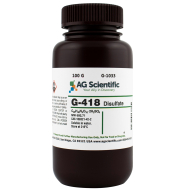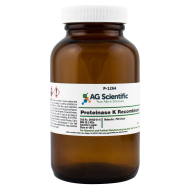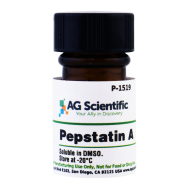There are many techniques that can be used to isolate high quality and high molecular weight DNA from mammalian somatic cells. However, these techniques are ineffective for mammalian sperm. Unlike somatic cells, nearly all histones in sperm cells are replaced by protamines held together by disulfide bonds, which compacts the sperm nucleus, rendering it resistant to conventional lysis procedures.
Sperm DNA Extraction
It has been a gradual process for the development of efficient methods for isolating DNA from mammalian sperm. Bahnak et al. reported a protocol using guanidine thiocyanate in a lysis buffer made with sodium citrate, sodium lauroyl sarcosinate (Sarkosyl), and β- mercaptoethanol (reducing agent) to isolate high quality mammalian sperm DNA. The DNA extracted was then successfully visualized in Southern blot analysis. The procedure required lengthy steps such as CsCl ultracentrifugation for 20 hours and dialyzing the banded DNA for 24 hours against Tris-HCl and ethylene diaminetetra acetic acid (EDTA).Proteinase K Shortened Procedure Time
The inclusion of proteinase K in subsequent methods to enhance the activity of chaotropic agents such as guanidine thiocyanate by digesting nucleoproteins eliminated the need for lengthy ultracentrifugation and dialyzing steps. In a method developed by Pacheco et al., sperm pellets were lysed for 16 hours in a solution containing Tris-HCl, dithiothreitol (DTT; another commonly used reducing agent), sodium chloride, EDTA, sodium dodecyl sulfate (SDS), proteinase K, and β-mercaptoethanol. DNA was then extracted using a phenol/chloroform protocol, and DNA was ethanol precipitated. While the authors were able to extract DNA used for subsequent DNA methylation analyses, the method still required at least an overnight incubation. The method also used harmful organic solvents (phenol and chloroform) that are undesirable for simple laboratory procedures. A method by Hossain et al. was one of the first to eliminate these overnight procedures from the sperm DNA extraction protocol.Proteinase K Eliminated Overnight Procedures
Hossain et al. modified the original protocol by Bahnak et al. for the preparation of human sperm DNA by including proteinase K in the lysis buffer (containing guanidinium thiocyanate) to digest nucleoproteins, and isopropanol to precipitate DNA. This modification eliminated the need to mechanically homogenize the cells, the use organic solvents for extraction, and the use ultracentrifugation for DNA precipitation.The degradation of DNA through mechanical homogenization and organic solvents was minimized, and the overall procedure could be performed in ordinary laboratory facilities in a reduced amount of time with only an incubation period of 3 hours for lysis needed. However, incomplete protein digestion and removal of chaotropic salts persisted limited the quality of the DNA yield.
Griffin's DNA Extraction Method
Modifications were made to Hossain's protocol by Griffin to increase the quality and yield of mammalian sperm DNA by eliminating incomplete protein digestion and removal of chaotropic salts that may coprecipitate with DNA. Descriptions of the lysis and extraction components as well as the steps of and modifications to Hossain's protocol were given in detail.Guanidine Thiocynate Enhances Proteinase K Activity
Guanidine thiocyanate is one variety of chaotropic agent employed during DNA extractions. Its functions include:- Disruption of the hydrate shell of DNA, rendering it insoluble in aqueous solutions
- Irreversible inactivation of RNases and DNases
- Disruption of the hydrophobic structures of proteins, metabolites, and other contaminants so that they become soluble in aqueous solutions
- Disintegration of cellular membranes
Guanidine thiocyanate enhances the activity of proteinase K, an enzyme that aids in protein solubilization and lysis. Creating hydrophobic and hydrophilic environments for DNA and proteins respectively is necessary to:
- Help bind the DNA to the hydrophobic silica membrane of spin columns in commercial extraction kits
- Remove proteins and other contaminants during subsequent washing steps
Reducing Agents
The replacement of histones with protamines, which are held together by disulfide bonds, compacts the sperm nucleus and renders it resistant to DNA extraction by traditional somatic cell methods. Therefore, the use of reducing agents to dissociate protamines from DNA using strong reducing agents is required. DTT and β-mercaptoethanol are examples of such reducing agents which cleave disulfide bonds and allow proteins to unfold. Griffin employed DTT in the lysis buffer because it is more effective and less toxic, works more efficiently, and has a milder odor compared to β-mercaptoethanol. Furthermore, even though SDS has previously been used in DNA extractions, it has a very low solubility in high-salt chaotropic solutions. Griffin employed Sarkosyl in the lysis buffer because it is soluble in high-salt chaotropic solutions and, like SDS, is used to denature proteins and disrupt cellular membranes.2 Hour Procedure for Extraction
Overall, lysis was completed within 2 hours using Griffin's protocol, whereas it took 3 hours to complete Hossain's protocol. After lysis, the addition of isopropanol allowed precipitation of DNA, and two subsequent washes with alcohol and sodium citrate removed any chaotropic salts into solution. The extraction method resulted in high quality, high molecular weight genomic DNA. It was a yield of approximately 80%, an A260/280 ratio ranging between 1.8 and 2.0, and an A260/230 ratio of 2.0 and greater (as expected for pure DNA). The DNA was efficiently digested with restriction enzymes and amplified by PCR.
Desirable results, but not a Go-To protocol for all instances
Despite these desirable results, a few issues do not make Griffin's sperm DNA extraction protocol ideal for clinical research:
- Lack of a protocol to stabilize DNA
- Lengthy period taken for lysis (2 hours)
- Unpleasant sulfur odor of DTT
- DTT becomes unstable in solution and must be prepared fresh for every extraction
The lack of a means to prevent DNA yield and quality degradation may potentially increase the cost of clinical research because degraded sperm DNA would constantly need to be replaced with new samples obtained from volunteers. A lengthy period for lysis coupled with the need to prepare fresh DTT for each sperm DNA extraction would make Griffin's methods inefficient for studies requiring large sample sizes. Therefore, Griffin's methods may only be best for applications where few patients or volunteers are needed to be tested over a short period, like at infertility clinics. Because clinical research typically uses large sample sizes over potentially large time periods, a more efficient method is required where large numbers of sperm samples can be collected and stored for a longer duration until DNA extraction and analysis begins.
Summary
The most recent method by Griffin gives a promising approach for consistently attaining high-quality yields of DNA. Furthermore, the Griffin approach has been validated by quality control methods that demonstrate:
- The ability to visualize sperm genomic DNA on an agarose gel
- The ability to perform restriction enzyme analysis
- Amplification of target regions using qPCR.
On the other hand, the method involves a lengthy lysis procedure (2 hours) and lacks a suitable storage procedure for maintaining stable yields of DNA and these limitations may hamper efficient clinical research for investigating male reproductive health. Even though several studies have been able to obtain DNA for downstream epigenetic profiling, none have incorporated the Griffin method.




